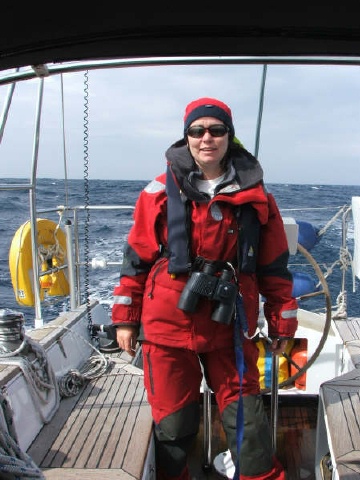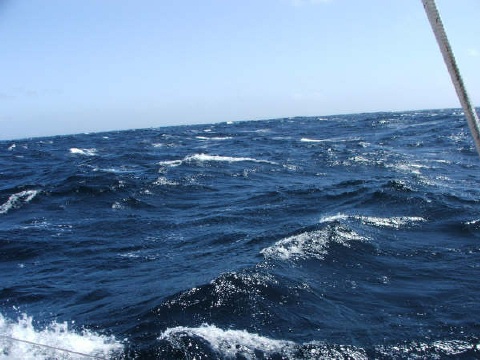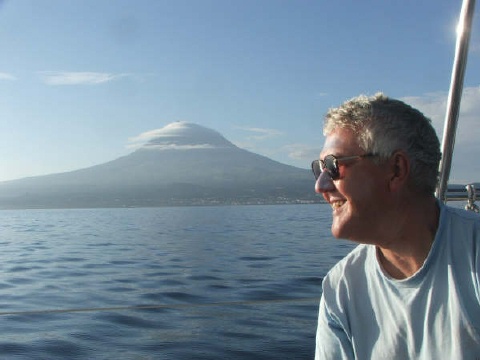
Dressed up for the North Atlantic...
Living the Dream — Part 1: The end
Azores to Kinsale, Ireland and Plymouth, England
Mid-June to August 2008
While waiting for the weather to settle and for our various boat works to be completed, we took advantage of the lull in our timetable and crossed the four-mile passage by ferry from Horta to the island of Pico. We hired a car for two days and toured the island, always dominated by the mountain peak after which the island is named. We paused in country lanes and wound down the car windows to listen to the silence of the island punctuated by the shrilling of the local bird life. We marvelled at the sheer cliffs, plunging perpendicular to the ocean, the proliferation of hydrangeas, which line the roadsides in continuous hedge. We drove through lush forests shading the roads and soaked up the peace and tranquillity.
We had decided to stay overnight on Pico and we had been recommended a hotel called Aldeia da Fonte. We did not book but found that they could accommodate us easily and we were pleasantly housed in a basic but adequate room, without television (hurrah), without a double bed (boo!), but with a clean and hard spraying shower (luxury). We ate pleasant local fare in the hotel restaurant that evening plagued by ants on the floor and table adjoining ours and Siobhán found her ankle severely bitten the next day.
On the second day we travelled to the other side of the island and went on a whale-watching safari (a wonderful surprise for my birthday) on a very fast rib, which bounced through the waves and swell in spine-jolting jumps. Eventually, after an hour of this uncomfortable but exhilarating ride we sighted a pod of about seven female sperm whales cruising along just on the surface at about two knots. We approached them to a distance of about 50 metres and marvelled at their grace. Then surprisingly and as if orchestrated for us a larger male approached the group and spent about 30 minutes with the ladies having ‘tea and tiffin’. We were informed that this was a rare observation, as the females cruise these seas regularly but the males cruise elsewhere on their own and only join them to mate. Having enjoyed their company he went off on his lonesome voyage again. By now I had exhausted our camera memory stick (512 Mb) and could take no more photographs. Some of our fellow explorers in the rib were very well equipped with telephoto lenses and a multitude of cameras. Some were even spending their whole holiday in these whale-watching trips and having had a taste of this arcane marine world, we could see how one could get hooked on sighting these mammoths from the dinosaur age. However, the voyage of discovery was only for three hours, so it was back to base with many dolphins spotted.
Surprise visit
We then headed back towards the ferry, and en route stopped at a wine cooperative to purchase different local wines, liqueurs and wine glasses at very reasonable prices (3 to 4 euros per bottle).
When we returned to our boat, we had a surprise visit from Graham and one of his sons, whom we had met in Bermuda and who had also come from Plymouth, and were on a two-year voyage just like us. They had had a particularly hard crossing to Horta and stayed for a while chatting about the trip and exchanging cruising chat. We promised to meet up when we both return, but we were leaving the next day so spent time preparing the boat.
When we finally came to check out of the marina in Horta, I was very pleasantly surprised to be presented with a bill for the two weeks stay (including water and electricity) for 157 euros (about US$ 200). This was a far cry from the amount required for one night in Newport, Rhode Island, USA, where they charge US$ 5 per foot per night or US$ 200 for a 40-foot yacht. I know where I would rather be moored.
On 16 June 2008, at 06.40 hours on a beautiful sunny day, we slipped our lines and passed out of the marina and headed off at 035º towards the western tip of Graciosa and onwards to Kinsale about 1,200 miles away. In a virtually cloudless sky, we motored until 15.00 hours, when the wind picked up to force 4.
Siobhán had written, ‘10a.m. Two sperm whales off our port side. Spotted their smoke. Have had a wonderful morning. Blue sky, flat sea, fresh home-made bread. Peace on board.’ It was to be a day for spotting unusual sea creatures, as at 14.10, I wrote, ‘A small pod of Risso’s dolphins (grey/white with a large hooked fin) spotted off Graciosa. Wonderfully relaxed and slow but large mammals.’
Having cleared Graciosa, we altered course to 046º and found that we had settled into our ocean regime quickly, with our 24-hour watch system. We have agreed that the old ambiance has been restored on board and with only 1,000 miles to travel to our next waypoint off the south-west coast of Ireland, psychologically we are more relaxed. As the last of the Azorean islands disappeared into the evening murkiness, I wrote, ‘Goodbye Azores. You were fun!’
The following morning at 07.00 we reefed down by two and still travelled at over six knots. It poured with rain during the morning, which is great for washing the grime off the sails and deck. By the evening the wind had abated and the swell died down. At 18.30 we spotted a pod of dolphins coming towards us in the distance but they didn’t show any interest and passed by a good way off.
By midnight at the start of 18 June, we were becalmed and the main was slatting, so we put a reef in it to stop the top of the roach from hitting the back stays. It is so easy to reef the new sails that we found this method of chafe prevention ideal. By 08.00 we were sailing along with full sails at six knots on a morning I described as, ‘…one-of-those-gentle-I-could-sail-forever days when the speed doesn’t matter’. By the afternoon we were again becalmed under a clear blue sky and sunbathed in the cockpit. Later, while I was asleep, Siobhán spotted a large orange buoy floating unattached in the middle of the ocean, so she practised her man overboard procedure and added a handsome roving fender to our fender wardrobe.
Change of weather

Big Irish seas
And so we progressed along our north-easterly rhumb line. Siobhán sighted two plumes of whale breath off our port beam, but not enough to photograph. At times we ran before a south-westerly breeze with sails goosewinged and at other times broad-reaching at seven knots accompanied by a small pod of common dolphins. It was another day for wildlife as we saw a large black whale cross our bow about 300 metres off. It was about five metres long with a pointed fin.
At 11.00 hours on 21 June, however, I logged, ‘Weather changed. Wind veered from west to north-west and then north and increased to near gale within 20 minutes. Third reef in main with half working jib and ran off to 100º due to increase in swell and wind. Reflects weather forecast at 09.00.’ By now, after all of the experience of gales we had had since leaving St Augustine in Florida, we were no longer apprehensive about strong winds, but did not become complacent either.
By 05.45 the next morning the winds had abated and we were becalmed again with the engine on to charge batteries. Early in the afternoon, Siobhán again spotted a runaway buoy and added it to her tally. At 17.45, I saw two whales (possibly pilot whales from the shape of their heads) travelling in the same direction as us but slower. I wrote, ‘Magnificent sight, including smoking and then one tail finned up and dived.’
Siobhán had a sighting the following morning at 04.30 with the moon up and the sun rising, ‘Whale off starboard bow with plume dissipating like a small grey cloud against the slate grey sea and light grey sky. Six dolphins swimming on the bow.’
On 23 June we waited for a forecast force 7 near gale to materialise and as the winds gradually rose and the swell increased we reduced sail until finally I took in the main completely and we sailed along at five to six knots on bare poles. In our wind direction and force log we recorded constant southerly winds between force 7 and 9 from 17.00 hours on the 23rd to midnight on the 25th. The wind then veered to westerly but maintained gale force strength.
At 03.30 on 25 June, Siobhán experienced three waves boarding from astern, one of which filled the bridgehead under the spray hood. Although the companionway boards were up, seawater poured below and damaged the computer and printer and the wave actually ripped away the life saving horseshoe and strobe light tied to the starboard quarter rail and our new Lewmar floating winch handle. Luckily we personally suffered no damage.
We were only 63 miles from the Old Head of Kinsale, so we reported to Valencia coastguard the loss of our horseshoe, as it was decorated with the name of ‘Light Blue’. The seas had become more severe, mainly because we had crossed the continental shelf and the seabed had risen from 4,000 metres to 200 metres.

Old Head of Kinsale? Looks like the skipper to me (ed.)
Finally we passed the Old Head of Kinsale and as we sailed up the river Brandon towards the beautiful town of Kinsale itself, we could smell the wonderful odours of the countryside wafting down to us; the new-mown grass and the pungent strength of the cow dung welcomed us to Ireland. Never was that country smell so appreciated.
We were delighted with our voyage from the Azores, as the 1,200 miles had only taken nine days and despite the loss of our computer, horseshoe and winch handle, we were both still hale and hearty. I was looking forward to my first pint of genuine Irish Guinness, but it was not to be for two days as there was no room in the marina, so we took up our usual position below the bridge over the Brandon, where we had anchored before our circumnavigation of Ireland and before we set out southwards towards northern Spain on our transatlantic adventure two years ago.
Eventually we were given a berth in the marina and with the help of Siobhán’s brother we removed eight trolley loads of our equipment to be stored in Siobhán’s mother’s house. We then prepared the boat for our onward journey to Plymouth from where we had initially started our voyage of discovery on 17 June 2006.
We eventually set out upon the final leg of our voyage from Plymouth to Plymouth on 20 July 2008 at 09.00 hours and headed for Land’s End. The 130-mile leg across the Celtic Sea was uneventful and we passed Longships Lighthouse and Land’s End between 11.00 and 12.30. At 14.00 hours, I wrote, ‘Passing across Mounts Bay with St Michael’s Mount, Marazion and Penzance on the coast. A truly beautiful day with high pressure of 1031 and brilliant sunshine with azure blue sky and wispy clouds. The north-westerly breeze makes everything very chilly and we are dressed with several layers accordingly. The sea is sparkling and it makes a change to have waves one foot high instead of a 20-foot swell. I can see the Lizard light winking from 12 miles away, which means we only have 26 miles to go to the Helford River anchorage and peace and tranquillity. Great to be back in English Channel waters again.’
Having passed the infamous Lizard in its most benign mood and heading north, we reached the Helford and one of our favourite anchorages at 17.00 hours and after two aborted attempts, due to the weedy seabed, anchored, switched engine off and enjoyed a flight of fancy by imagining we were in Daphne du Maurier’s novel ‘Frenchman’s Creek’. If one discounts all the other pleasure craft surrounding one, it is possible, believe me.
After a most pleasant restful evening and night, we ventured out again into the English Channel and sailed peacefully towards Fowey, our first big adventure destination several years ago, when we sailed in our first owned boat ‘Maid of Honour’, a Sadler 29. As we sailed past St Anthony’s Head at Falmouth, what a delight it was to our eyes to see dozens of yachts sailing in the Falmouth Roads at 10.30 on a Tuesday morning. Moreover there were sails in every direction in the Channel.
Fowey holds many sweet memories for us and it was a delight to once again glide into the inner harbour. It was, however, full to bursting with yachts, rafted up three deep on the larger buoys. We chose to sail further up river and found a pontoon berth empty and spent two charming days and nights in Fowey, walking the streets, enjoying the local fare and just soaking up the gentle atmosphere of the town.
But finally it was time to end our dream voyage and head to Plymouth, Devon, England, where we had started two years, one month, one week and one day ago. So at 09.00 hours on 24 July 2008, we slipped our lines and headed down the river and out into the Channel and into the teeth of the easterly force 5 wind. The 25 miles to Plymouth Sound is a straight rhumb line past Rame Head and Penlee Point, turn right, past the breakwater into the Sound and straight across to the Mountbatten Pier and thus into Plymouth Yacht Haven, where we had arranged to be lifted the following morning.
‘An easy sail’, I had said to the fellow sailors on the Fowey pontoon, who had let go our lines. What a silly assumption! It was to be a cold and windy day beating into that wind that rose to force 7, tacking for an hour south out into the Channel and then tacking back towards land several times. What a change from the winds of the Atlantic, the zephyrs of the Chesapeake, the steady easterlies of the Caribbean. We persevered and we persevered and the pointed top of Rame Head would not get closer. Eventually, at 18.30 we arrived at Plymouth Yacht Haven, with a sigh of relief. What a way to finish off the trip. We treated ourselves to a slap-up meal in the new restaurant, ‘The Bridge’ at Plymouth Yacht Haven.
Since then we have been living on the boat on the hard, and the rain and gales have not stopped, so the work we had set ourselves to do in a week before being launched again has been stretched out to three weeks, but ‘Light Blue’ looks as well now as when we first set foot on her four years ago. She has done so well at protecting us through the rough seas of the Atlantic and has given us years of exciting sailing. Thank you.
Sadly for us, she is now for sale, but fortunately for the next owners, she will carry them over thousands of miles, comfortably, warmly, strongly and enjoyably.
We are moving onto a new project in Ireland; the resurrection of a 200-year-old farmland cottage and the planting of an orchard of Irish apples and pears. Siobhán is returning to work after two years of intense ocean travelling.
To all our readers, thank you for following our adventures, our living dream and travelogue. I hope you have enjoyed it as much as we have and that it has convinced you that ordinary people can achieve their dreams with a positive mind and a supportive partner. Live the Dream! Go on! Life is not a dress rehearsal!
With lots of love and best wishes for your future.
Lawry and Siobhán Nunn,
080808 @ 08.08hours.
Stay online for the next episode of 'Living the Dream — Part 2: The beginning'
Go to the ... Archives
... or see the photos from this report
